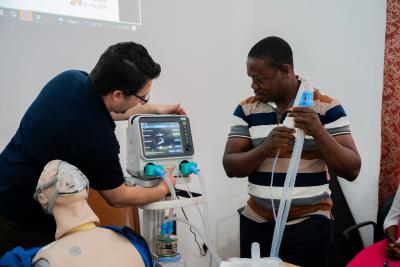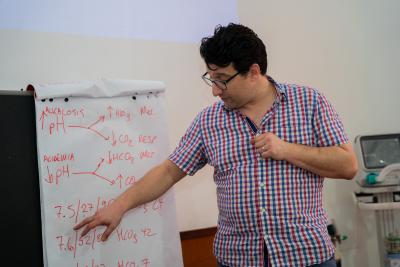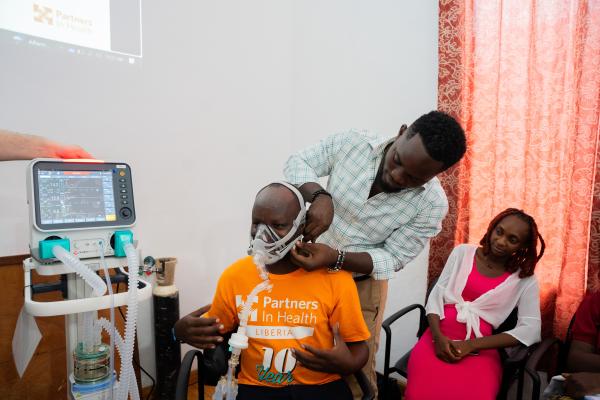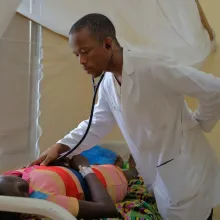In rural Liberia, Maryland County, a critical care revolution is underway. Partners In Health (PIH) Liberia, in collaboration with the County Health Team (CHT), is working to enhance health care access in a region where advanced medical resources have historically been limited.
Before Partners in Health (PIH) became involved in Maryland County, 9 out of 10 individuals needing emergency care, critical interventions, or lifesaving surgeries were at a high risk of death or severe disability due to the lack of a surgeon in the southeastern region. However, this situation is changing. PIH is working closely with the Government of Liberia to transform the James Jenkins Dossen (JJD) Hospital, a facility that previously had only one general practitioner, into a preferred health care institution. These efforts aim to establish Maryland County as a model for innovative rural health service delivery in Liberia.
As part of these transformative initiatives, a four-day intensive mechanical ventilation training was recently conducted for 32 doctors and nurses at the PIH-supported James Jenkins Dossen (JJD) Memorial Hospital in Harper.
The Training’s Impact on Clinicians
For many clinicians, the training was a turning point. Dr. Davidlene Reeves, a general practitioner in the pediatrics department at JJD Hospital, described the training as a pivotal moment of professional growth.
“What’s exciting is learning how to use the ventilator,” she said. “Now that we’re gaining practical experience, it’s a big step forward.”

Dr. Paul Sonenthal (left) shows Dr. Beyan S. Gweama (right) how to calibrate the mechanical ventilator. Photo by Ansumana O. Sesay / PIH
Amos Barway, a registered nurse and critical care fellow, admitted,
“This is my first time seeing a ventilator in a practical sense.”
The training refreshed his knowledge of arterial blood gas (ABG) analysis and taught him how to manage patients who are ventilator-dependent effectively. Dr. Siafa Rogers, an intern doctor, echoed this sentiment, calling ABG analysis the “most exciting new knowledge” he had gained. He explained how the training simplified complex concepts, enabling him to confidently interpret results and apply them to patient care.
The training also strengthened inter-departmental collaboration. Roosevelt Yancy, an anesthetist, highlighted how Emergency Room (ER) personnel now have the skills to intubate patients, reducing reliance on specialized units like the Operating Room (OR) and the Intensive Care Unit (ICU). This streamlines patient care and improves efficiency.
PIH emphasizes that without the necessary physical resources, staff cannot effectively utilize their newly acquired skills, leaving the training’s full potential unrealized. Conversely, having advanced equipment without properly trained personnel is equally ineffective. Instead of short-term, isolated interventions, a comprehensive approach is essential for creating lasting change in resource-limited healthcare systems. “Functional ventilators will help save more lives and reduce mortality and morbidity within our society,” Roosevelt stated.
Ventilators as Lifeline for Patients
The direct impact of this training is on patient outcomes. Margi Mabande, a clinical mentor in the ER, emphasized that approximately 30-35% of her daily cases involve respiratory failure. “This intervention (training) is very timely,” she said.
Dr. Rogers pointed out that conditions like hypercapnic respiratory failure (a condition where the body cannot remove enough carbon dioxide from the blood) often result in fatalities due to the lack of ventilators. “With this training and the availability of equipment, we can do something better (provide better care) for patients in respiratory failure,” he explained.
Strengthening the System Beyond the Classroom
Paul Sonenthal, Director of Inpatient Medicine and Critical Care at PIH, described the training as part of PIH’s “five S’s” framework for health system strengthening: Staff, Stuff, Space, Systems, and Social Support. This program aims to equip staff with the expertise to manage severe respiratory issues effectively.
The training also addressed logistical challenges. Yancy noted the delays caused by the distance between the ER and the OR for emergency intubations. With ventilators now available in the ER and trained personnel on-site, critical interventions can be initiated promptly, improving patient outcomes.
The Power of Ongoing Education as A Continuous Journey
The emphasis on continuous learning is deeply embedded in PIH’s philosophy. Dr. Sonenthal emphasized that health care cannot thrive without continuous education. “We’re constantly striving to improve ourselves,” he stated. He underscored that while initial training lays the groundwork, true mastery and the institutionalization of complex skills require continuous reinforcement, problem-solving in real-world situations, and peer-to-peer learning.
“This four-day training is just the beginning of a long-term process of supporting, mentoring, and accompanying our colleagues,” Dr. Paul Sonenthal explained. “Our plans include bedside mentorship, remote case conferences, and ongoing visits to ensure continuous development.”
Dr. Rogers echoed this sentiment, stating, “Medical training is continuous, and it’s vital to remain open-minded and willing to engage in as many training sessions or professional development opportunities as possible.”
Ms. Mabande quickly recognized the challenges ahead, as her team members were unable to attend the training. She explained, “Having the knowledge alone will not help all my patients, but sharing the knowledge will ensure my patients are always cared for.” This dedication to knowledge sharing creates a powerful multiplier effect.
A Vision for Equitable Care
Dr. Sonenthal articulated PIH’s overarching goal: to ensure that, whether someone lives in Harper, Liberia, or Boston, Massachusetts, they receive the care they need for respiratory failure.
“This preferential option for the poor drives PIH’s mission to provide the best possible care to all.”

Dr. Paul Sonenthal explains scenarios during a large group presentation with participants at mechanical ventilation training. Photo by Luther N. Mafalleh / PIH
The impact of the training is already evident, with participants’ pre- and post-test scores improving dramatically—from below 50% to around 80%. Dr. Sonenthal praised the participants’ enthusiasm and engagement, calling it a sign of a brighter future for health care in Liberia.
The mechanical ventilation training in Liberia is more than a technical course; it’s a testament to PIH’s unwavering commitment to building a resilient, equitable health care system where every patient, regardless of location or condition, has a chance at life.
Together with the Ministry of Health, PIH is working to establish a hub-and-spoke model – leveraging the specialist staff and services available in Maryland to support clinical operations, regional readiness, and leadership in the remaining counties. PIH is building Liberia’s next generation of health care providers through capacity building in the form of medical education, training, and continuous mentorship and accompaniment. Investments in local human capital enable us to strengthen and stabilize the health system over the long term.



